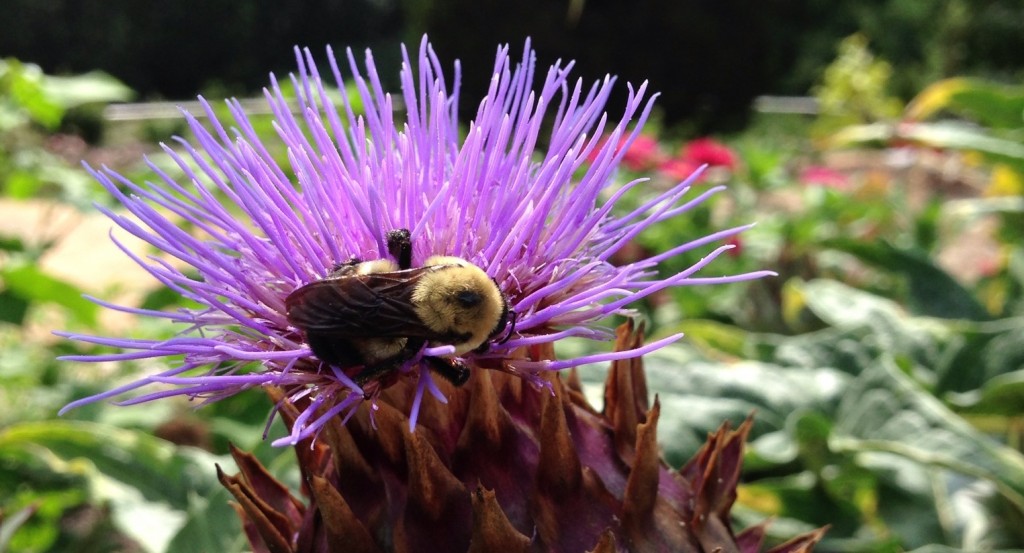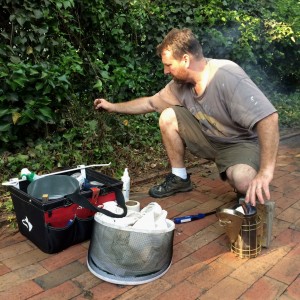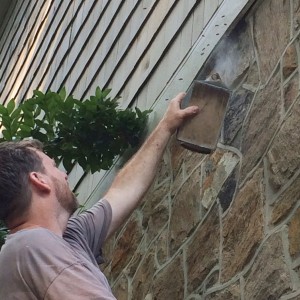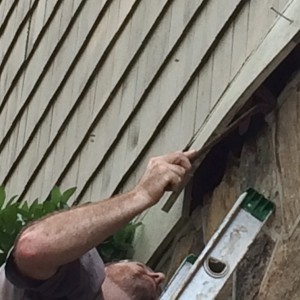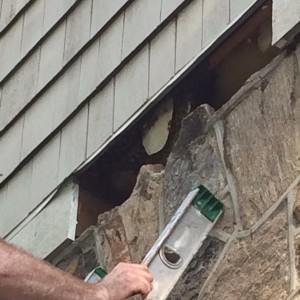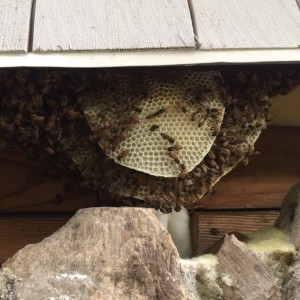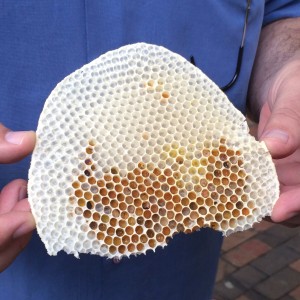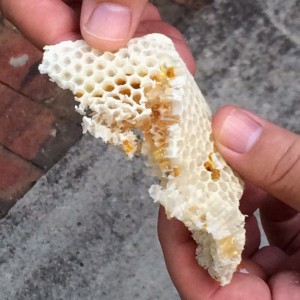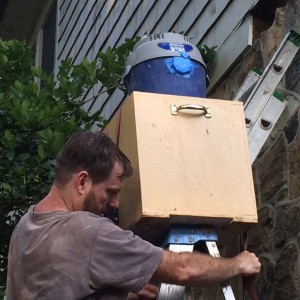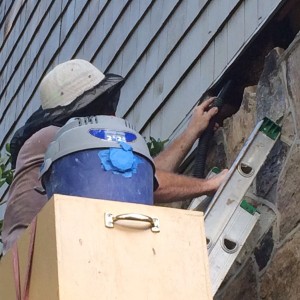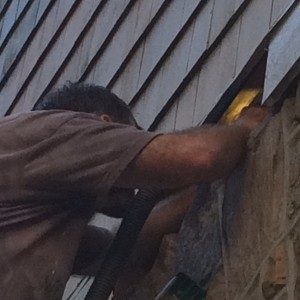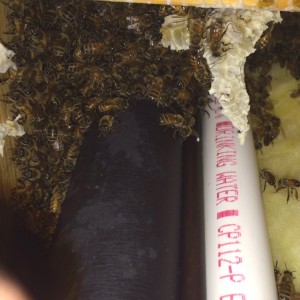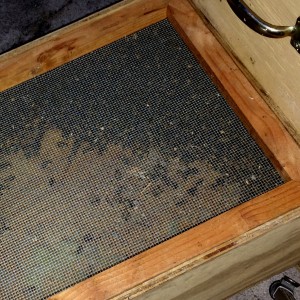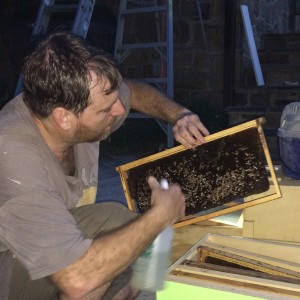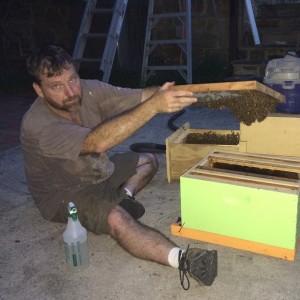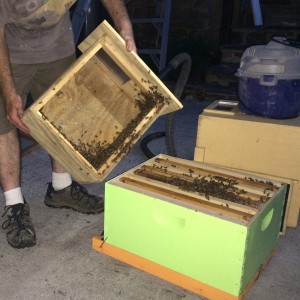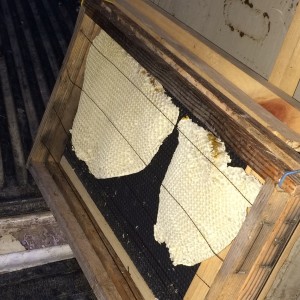Many of you know Marty Hanks at Just Bee Apiary from our local farmers markets, coffee shops displays, and school events. He’s been building awareness in the Triangle area about bee-keeping and sustainable practices for years now. It’s a slow process to reach out to hundreds of thousands of people and educate them about tiny creatures that fly around and pollinate our local food supply and make delicious nectar that lasts virtually forever. But as you begin to understand the seasonal impact of wild and harvested fields, crops, flowers, trees, rain and temperature ranges, you can see how every variable contributes to the honey and how important even small individual decisions you make in your life might affect these masters of creation.
Which brings me to the point of this particular post. Bees are in serious decline. No matter what the reason you believe is causing this, there is reason to be concerned because most vegetables and fruits are pollinated by bees and other flying insects. Saving every honeybee hive is important before they go the road of extinction. So when a homeowner calls and says, I have a hive of honeybees that needs to be removed and there’s a time window or cost associated with this process, Marty, as do many of the bee-keepers around the country, spring into action to gather the hard-working hive up and move them to a better location.
His goal in the process is to create the least amount of stress for the hive, capture the queen so the hive stays together, move some of their comb to retain their scent, and get every last one of the little foraging creatures as they fly home in the setting sun. So please pardon some of the pictures as I still use an iPhone for my work! As a note, Marty uses one too to light up the inside of the house frame and take a picture or two when he’s extracting in addition to his head lamp. Technology at work. Ya’ gotta’ embrace technology some days!
So this story begins just around 6 pm as the sun begins to set. Not far from my house in a neighborhood where I walk my dogs is a lovely house with a lovely garden. The lemony scent of the magnolias waft through the breeze this particular evening and you can see why the bees have chosen this location with garden roses and gardenia to locate. This hive plans to enjoy the rewards of a good set of gardening neighbors with lots of flowering trees, shrubs and flower beds. Marty has already been here once earlier in the week to examine the location. The hive is very calm and it’s a cool summer night, so he has only brought along a small bit of head-gear, (mainly because he got “lit up” in the face earlier in the week with another hive). It’s easy for me to get close and set up my tri-pod and phone. Marty explains that I should consider myself a “tree” and the bees will tend to land on me, but remaining calm will keep them calm as well.
He’s planning to use just a bit of smoke to mask the pheromones chemical reaction that they will send out through the hive as an alarm that something is disturbing the hive. The smoke will trigger a genetic response, like that of a forest fire. Instead of stinging and protecting the hive from the intruder, the bees will go into the hive and cluster to feed on the nectar to take it to a new location and use the energy from their own nectar (think carbohydrates here) to rebuild new combs. That process is very energy intensive, so it’s important to move hives when they have time to rebuild their combs and to add to their own stores of honey to survive winter when there is little for them to forage and feed themselves. That’s why many bee-keepers that pull honey in the fall keep that honey to feed the bees should the winter be severe or drag on, like we had happen this year. Or they simply will not pull any honey near the end of the season.
The first ladder is set up against the home and left for a few minutes so the bees resettle. During that time, the smoker is lit and gets going on the ground. This process just takes a small amount of time. Marty has even built a tin holder so he doesn’t start any fires when he is out in the woods or field with a hot smoker. At this location, we have a concrete drive to work on, with the benefit of electrical outlets nearby, so getting into the hive will be relatively quick using power tools, albeit noisy for the hive. A simple set of tools is used to pry off an outer board and it’s pretty evident that failing pointing in the wall has created several gaps that made it easy for the bees to get underneath and find a cool location on a HVAC and water line to set the hive in place. Fortunately, this hive just arrived a couple of weeks ago and there are just a few combs in place, but the hive size is remarkable so it will be important to find the queen and isolate her if possible in her own little box to keep her safe and well. As the sun fades, it will become more difficult to spot her exceptional green colored dot. But other bees will naturally protect her so clustering is a second way to locate her.
Extracting bees by suction is not Marty’s preferred method, but since the hive has crawled up into the home’s structure, it’s the only option in this case for a speeding recovery of the workers. Out comes a unique creation box and vacuum that uses a very low horsepower shop vac attached to a box with screen mesh that will contain the bees. To the bees, this is the equivalent of a tornado so Marty moves as quickly as possible gathering up the clusters of bees on the combs before breaking off a couple of pieces of comb in the front of the opening. The two large pieces of combs are put into one of the frames for the hive box because they contain the scent that is unique for this hive. The other frames are for the hive to use and rebuild. A couple of the combs contain more than just pollen. There’s a bit of nectar-honey and some seed bee eggs that look like itsy-bitsy particles of rice. The honey in the hive is quite sweet as we taste from a broken comb piece.
As Marty is gathering up the bees with the now, rather loud, shop-vac, which, did I mention, is precariously attached to a second ladder next to him, he notices the bees have been chewing through the packed insulation of the house to get further up the water and HVAC line to a cooler location. The white dust that is left behind is the evidence of their destructive capability when building a home. Some of this gets into the honey comb, but most of it just falls down into the cavity of the home’s outer wall. The process continues for the better part of an hour. And this is just about the time, we notice that the bees are still climbing along a rafter and up in a spot Marty had not seen before. So he pulls down a little more insulation to get a better look. And out comes another large bunch of bees! This is when Marty is probably wishing he might have started just a tad earlier because it is evident, we’re going to be here a while longer.
The good news is that there are not many left and Marty has switched out his had and mesh for a simple head-lamp to help him see into the void of the wall as he continues to reach his arm up into the framing and pull down handfulls of bees. They are quite calm still and he’s been able to make quick work of it with just a few stings. But all in all, he seems pleased with the progress although it’s taken more than a couple of hours up on the ladder at this point to pull them out safely.
The neighbors look on at the process by the side fence and we are periodically taking breaks to show them a little of the comb and explain the process. During the breaks, the foraging bees can return and go back into the hive and settle down. A little smoke, a little more vacuum action and finally Marty spots what he thinks might be the queen surrounded by a mass ball of bees the size of his fist. He able to get the mass but not isolate the queen, which would be the best of circumstances. He won’t be able to look for the queen now until Sunday or Monday when he’ll move the hive again to a stable location.
Now the process of moving the bees from their captured box into the hive box begins, in the dark of night. The bees will be calmer moving without much light and with the old combs set in place. The new hive box has been sprayed with some sugar water for temporary food while they are stressed and using up lots of carbohydrates. Many will “fan” out their tails to tell other returning bees that this is now the new home. With the old combs and scent in place, the bees signal each other to come on inside and settle for the night! We are able to get quite close to the bees without any protection and witness them doing their little dance and moving on each frame as Marty spaces them out evenly. He’s getting the bees more evenly dispersed on each rack. The bees are more concerned with the effort of getting everyone home and safe, rather than bothering with us or Marty as he moves about them quite freely now. The cat at the neighbor’s cat is now mildly interested and gets a few feet closer, but somehow knows to stay on the log pile several feet away while observing us.
The frame is set up with an upper screen to allow air movement and then a hard frame to keep out the elements and allow stacking of frame boxes. At this point, Marty is carefully gathering up all of the leftover bees on the ground and pushing them gently into the hive with a very soft long-bristle brush that reminds me of an architect’s drawing brush. A few are harmed or killed in the process as we move around in the dark and accidentally step on one or two. Only a few have been harmed in the process considering the size of this hive. Marty is estimating 6-7 pounds based on his experience. Any that are left will either return to their original hive, which should be close by, or they will die without their queen. It’s important to get as many as possible with the decline that bees are currently experiencing world-wide. Every single one counts in this battle to save these gentle pollinators.
Once completed, Marty uses painters tape to seal up the hive while he transports them later in the evening. He still has to seal up the old hole and hive totally for the stragglers that might return. The goal is to send them back to their old hive if possible and not have them die in a location that is now without a queen. A few more minutes in the dark, up on the ladder to replace the board and seal the seams with painters tape again. Some permanent repairs need to be made along the entire perimeter to avoid this from happening again. In the meantime, with that work completed, we roll up the extension cords, put away all of the equipment and ladders and finally move the bee box into the back of the truck for transport. It’s just around 9 pm when I finally leave and Marty still has about another hour of work left before he can head home.
He comments that bee-keeping is a 24/7 job. I believe him. Honey is really a rare commodity. It takes thousands of miles of flying by each bee and endless hours of building a hive with countless perils from climate, chemicals, moving objects and predators to create a nectar that can last thousands of years safely. It is a golden gift from the smallest of creatures.
If you want to catch up with Marty or buy some of his delightful honey, check out the Carrboro Farmers Market on Wednesdays or the Southern Village Farmers Market on Thursdays.

